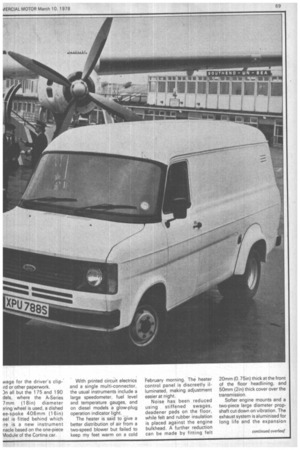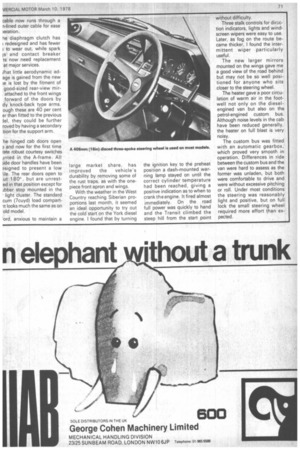Facelift and new engine for Transit
Page 70

Page 71

Page 72

Page 73

If you've noticed an error in this article please click here to report it so we can fix it.
THE FORD Transit has just had its first major facelift, detail improvements apart, since it was launched in Europe in 1965. But the model range from the 80 to 190 still covers the same gvw range from 2070kg (2.04 tons) to.3,500 kg (3.44 tons).
The Essex vee-four engine is no longer available on any model and is replaced by the two litre Cortina ohc engine which produces 57kW (76bhp) at 4,500rpm.
The 1.6 litre ohc engine, with a power output of 48kW (64bhp) at 4,750rpm is the standard unit for all shortwheelbase models, but the 1.6ohv Kent engine is retained for the 1 3 -seate r crewbus and the new 120 model.
. A down-rated version of the two-litre engine developing only 43kW (58bhp) is expected to give up to 10 per cent saving in fuel. Maximum torque is slightly reduced but its peak is lower down the rev range and so encourages better use of the gearbox.
The York diesel is available on all models in the range. The ether cold start system has been dropped in favour of a glowplug-in-head system, combined with a positive dash mounted light-out arrangement, which indicates when sufficient preheat temperature has been reached inside the cylinder. It is claimed that this system will give a starting ability down to —20°C(-4° F).
Previous shortcomings of the York engine are said to have been improved. The oil pump has a proper 0-ring oil seal in place of the original paper gasket. Camshaft oil seals are latexdipped to stop leaks. The timing belt is stronger and the profile of the pulley wheels has been altered to reduce wear.
At the assembly stage all injector pipes are ultra-sonically cleaned to reduce the possibility of dirt getting into the fuel system. The dipstick has been changed to prevent any oil from the sump being blown past, and a larger bearing has been fitted to the water pump.
A vee-six petrol engine is still available, but only as a special vehicle option. The ride is also said to have improved by better matching of the spring rates to the gvw, and the addition of shackes to the rear springs.
On passenger carrying vehicles gas-filled monotube dampers replace hydraulic dampers and give a less harsh ride, especially noticeable when lightly laden.
The main objective of the restyle, says Ford, has been to improve the van as a workhorse, while at the same time modernising its appearance. In the belief that cab comfort is essential to the vehicle's continued success, the maker has paid a great deal of attention to working environment of driver.
The seats are contoure provide extra support and available in embossed vinyl cloth trim similar to that us( the Transcontinental. The fi slopes away from the w screen, with a ridge along bottom edge providing u
wage for the driver's clip-. ird or other paperwork.
Dn all but the 175 and 190 dels, where the A-Series 7mm (18in) diameter .ring wheel is used, a dished ee-spoke 406mm (16in) eel is fitted behind which le is a new instrument nacle based on the one-piece Module of the Cortina car. With printed circuit electrics and a single multi-connector, the usual instruments include a large speedometer, fuel level and temperature gauges, and on diesel models a glow-plug operation indicator light.
The heater is said to give a better distribution of air from a two-speed blower but failed to keep my feet warm on a cold February morning. The heater control panel is discreetly illuminated, making adjustment easier at night.
Noise has been reduced using stiffened swages, deadener pads on the floor, while felt and rubber insulation is placed against the engine bulkhead. A further reduction can be made by fitting felt 20mm (0.75in) thick at the front of the floor headlining, and 50mm (2 in) thick cover over the transmission.
Softer engine mounts and a two-piece large diameter propshaft cut down on vibration. The exhaust system is aluminised for long life and the expansion boxes are double skinned for quietness.
Ford's C3 automatic transmission is available for most models fitted with the two-litre (122cuin) ohv engine. Extensive use of aluminum has kept the weight down to 45kg (1001b) which is about the same weight as the conventional four-speed manual box.
Torque converter ratio has been uprated ffom 2.17 to 2.35 to 1, reducing the need for down-shifts under load, which improves the absolute gradeability to 30 per cent (1 in 3) at 2,350kg (2 ton 6 cwt).
The lock-down facility in both low and intermediate gears allows engine braking to be used more readily during hill descents and gives greater flexibility to cope with bad roads. Before fitting, all units are tested for correct operation on a computerised test rig.
The automatic gearbox control lever is mounted on the floor on the driver's left and is better sited than the conventional gearshift. It allows easier walkthrough access to the near-side door.
The new model's reduced maintenance times will play a substantial part in increasing efficiency of operation and reducing overall running costs. The period between services has been extended to 20,000km (12,000 miles) for a main service and 10,000km (6,000
vmilees) for an intermediate ser icMany of the previous routine adjustment procedures are now unnecessary while access to
components has been imp — battery, brake fluid res and wash bottles all have parent casings so that leve be checked at a glance.
Front and rear brakes c inspected for wear wi removing the wheels.
servo-assisted twop calipers introduced in 19' the front wheels continue short wheelbase model, four-piston ventilated ca are used in the 175 anc 3.5 tonne model.
The rear drums are adjusting, the handl leverage has been improve :able now runs through a n-lined outer cable for ease )eration.
le diaphragm clutch has t redesigned and has fewer ; to wear out, while spark is and contact breaker ts now need replacement at major services.
/hat little aerodynamic adage is gained from the new )e is lost by the fitment of good-sized rear-view mirattached to the front wings forward of the doors by dy knock-back type arms, ough these are 40 per cent er than fitted to the previous iel, they could be further roved by having a secondary tion for the support arm.
he hinged cab doors open a and now for the first time rate robust courtesy switches J nted in the A-frame. All ;ide door handles have been asigned to present a low 'ile. The rear doors open to ut 180° , but are unrested in that position except for ibber stop mounted in the
• light cluster. The standard cum (7cuyd) load compartit looks much the same as on old model.
'ord, anxious to maintain a large market share, has improved the vehicle's durability by removing some of the rust traps, as with the onepiece front apron and wings.
With the weather in the West Country reaching Siberian proportions last month, it seemed an ideal opportunity to try out the cold start on the York diesel engine. I found that by turning the ignition key to the preheat position a dash-mounted warning lamp stayed on until the correct cylinder temperature had been reached, giving a positive indication as to when to crank the engine. It fired almost immediately. On the road full power was quickly to hand and the Transit climbed the steep hill from the start point without difficulty.
Three stalk controls for direction indicators, lights and windscreen wipers were easy to use. Later, as fog on the route became thicker, I found the intermittent wiper particularly useful.
The new larger mirrors mounted on the wings gave me a good view of the road behind but may not be so well positioned for anyone who sits closer to the steering wheel.
The heater gave a poor circulation of warm air in the footwell not only on the dieselengined van but also on the petrol-engined custom bus. Although noise levels in the cab have been reduced generally, the heater on full blast is very noisy.
The custom bus was fitted with an automatic gearbox, which proved very smooth in operation. Differences in ride between the custom bus and the van were hard to assess as the former was unladen, but both were comfortable to drive and were without excessive pitching or roll. Under most conditions the steering was reasonably light and positive, but on full lock the small steering wheel required more effort than expected.




















































































































